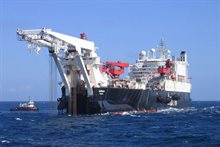Cables and pipelines
On the Dutch Continental Shelf alone, there are approximately 4,500 kilometres of pipelines and 6,000 kilometres of cables. More than half of the cables are no longer in use. On both sides of the cables that are still in use, an area of 500 to 1,000 metres has been designated to perform the necessary maintenance. Due to the construction of new offshore wind farms, a larger number of high-voltage cables for electricity transport will be required. More new telecom cables can also probably be expected.
No obstacle for shipping and fishery
When planning and granting permits for cables and pipes, other uses must also be taken into account. Based on the principle that space must be used efficiently, cables and pipelines should obstruct other uses as little as possible.
Cables and pipelines must be installed in such a way that they do not endanger or impede shipping and fishing. This means that they must be buried at sufficient depth to ensure safe fishing and navigation. No sand may be extracted and ships are not allowed to anchor on locations where there are cables and pipelines. All cables and pipelines together constitute a significant limitation of the available space for wind energy, sand extraction and anchoring locations. There would be more space for these functions if the cables and pipelines were bundled. Anchoring on cables and pipelines should be avoided wherever possible. During the planning phase this is done by forbidding cables and pipelines in anchoring locations. Furthermore, cables and pipes should cross waterways in the shortest and straightest possible way. In addition, new cables are included in shipping charts as quickly as possible so that the shipping traffic knows where they are located.
Harmonising the laying of cables and pipes
For the extraction of surface minerals and wind energy, cables and pipes can pose major obstacles and may need to be harmonised. For the sand extraction strategy, it has been considered to balance the costs of having sand extraction take place further away against the costs of diverting the cable. For example, it might be cheaper for a cable or pipe operator to pay compensation and lay cables or pipes through sand extraction areas rather than lay them around a particular area.
Responsibility of operators
Pipe operators are themselves responsible for ensuring that the pipes are (and remain) securely laid and must report to the supervisors every year. This obligation does not apply to telecom cable operators, but it does apply to high-voltage cables. Cables and pipes that are no longer in use must, in principle, be removed.


